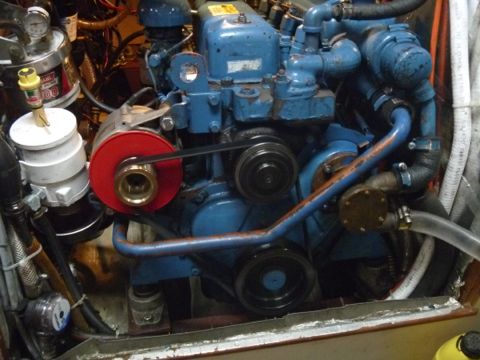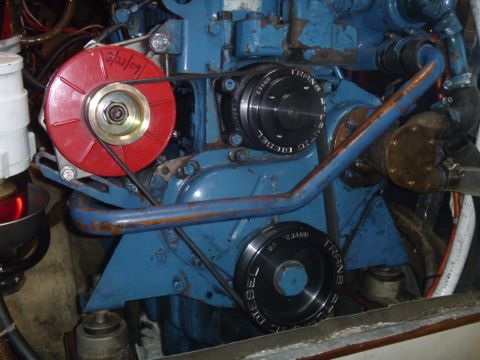
The model 621 is Balmar's 6 series alternator with the saddle shape that fits the old Perkins. I went with the 120 amp version of the 621.While the 4.108 can easily drive a bigger alternator, the skinny belt that turned the Delco can't. Problem is the skinny belt also ran over the coolant water pump, and the crank pulley, and both were sized for the skinny belt. TAD (Trans Atlantic Diesel) offers a package to correct this whole skinny belt limitation. The alternator pulley is actually a bit wider than the belt to allow some adjustment. I talked to the TAD people about this, and they confirmed they do this intentionally; allows some tracking adjustment and runs fine.


While the Delco and the old water pump came right off, the crank pulley can be a bugger to remove on a CD36. I used a standard water heater socket (1-1/2" with 1/2" drive) and a breaker bar, but turning the bolt just turns the engine. Some recommend removing the starter and putting a pry bar into the teeth to hold the engine in place, but the starter on a CD36 is nearly inaccessible. However, the thoughtful people at Perkins left three threaded holes in the crank pulley itself that can be very useful here. Thread a bolt into one of the holes and use it to stop the engine from turning as you back the crank bolt out. The bolt came out easily, and the old pulley slid right off - no wheel puller needed. The wide TAD pulley slips right on, and I used a strap wrench to hold keep the pulley from turning as I torqued it down (220 ft/lbs). A bit of blue thread-locker is good insurance.

The TAD serpentine belt package includes a new coolant water pump with wide pulley already installed, a new wide crank pulley, a wide pulley for the Balmar alternator, and the wide belt for the system. Also included is an slightly longer hose to move some plumbing out of the way of the new wide belt. The belt is a standard NAPA Micro-V, AT 25-060400. The whole system works really well, and with a Balmar ARS-5 voltage regulator, the AGM batteries are now well fed.
(Note: That new bronze raw water pump isn't part of this project.)

Cranking out the amps! I noticed the Balmar literature states amperage output in alternator rpm. Where the crank pulley is 2-1/2 times the circumference of the alternator pulley, this 120 amp Balmar 621 is actually cranking out over 115 amps with the engine turning just 1,000 RPM. And if that's not enough, it's now easy to upsize to an even larger alternator now that the serpentine belt system is in place.
A few things I encountered along the way here:
1) The Balmar 621 doesn't ground itself to the engine through its case like an old car alternator - the Balmar is an "isolated ground" alternator. This means you have to connect the Balmar's negative terminal to ground via a huge ground wire (black). Isolated grounding doesn't matter much in fiberglass boats, but keeps this type of alternator a viable option for aluminum hulls that can be damaged by stray currents.
2) This older Balmar ARS-5 regulator has two black ground wires. One goes to the (-) on the Balmar alternator, the other has to be grounded elsewhere off the alternator.
3) My boat did not have a brown/white wire coming to the alternator from the ignition switch, despite what the wiring diagram says. With the back side of the engine panel exposed within the sail locker, it was easy enough to connect & run a new brown wire from the switch down to the ARS-5. May as well run a new tachometer wire while at it, as the tach is fed from the ARS-5 too.
4) My new coolant water pump wouldn't sit flush on the engine until I moved an oval washer from the front engine cover that was in the way. It would be easy to miss this and just bolt the new water pump down, surely causing a coolant leak. Be sure the new pump sits flat & isn't rocking on something before you bolt it down.
All in all, this was a great weekend job that will provide lots of amps for years to come, a job well worth doing.
Cheers,
John Ring
CD36 Tiara

